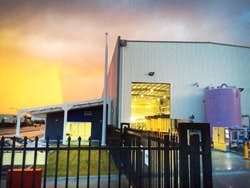About the author: Chris Morris is geography manager for CH2M Hill Australia and New Zealand. Morris can be reached at [email protected] or +61.2.9950.0200.
Hunter Water, a state-owned corporation providing water and wastewater services to more than a half-million people in the lower Hunter region of New South Wales, Australia, recently celebrated the commissioning of the new $73 million Kooragang Recycled Water Scheme (KRWS). The plant is capable of producing 3.3 billion liters of clean water per day, and the advanced water treatment plant (AWTP) included in the KRWS will supply recycled water to industrial users on Kooragang Island, New South Wales, via a new 8-km pipeline that runs under the Hunter River.
CH2M Hill, as part of the Hunter Treatment Alliance, in partnership with Lend Lease and Hunter Water Corp., designed, constructed and commissioned the AWTP—a $40 million project to secure future water supplies in the lower Hunter region through industrial water reuse. The recycled water scheme consists of a 750-meter pipeline to divert treated effluent from the Shortland Wastewater Treatment Works (WWTW) to the recycled water plant at Steel River.
Plant Infrastructure
The recycled water plant consists of a diversion main from the Shortland WWTW effluent discharge pipe to the AWTP, a raw water storage tank with a capacity of 700 cu meters, preformed monochloramines dosed prior to the microfiltration (MF) feed pumps, and a microfiltration (MF) system comprising Microza membranes. The MF provides 4-log reduction values for bacteria and protozoa and 0.5-log reduction values for viruses. The recycled water plant also consists of a reverse osmosis (RO) feed storage tank with a storage capacity of 2,000 cu meters, and low-pressure RO feed pumps that pass MF filtrate through cartridge filters through to the RO system comprising ESPA2LD brackish water membranes. The RO provides 2- log reduction value for viruses. Permeate flows on to the degas tower, where pH is adjusted using caustic soda before passing through the CCT tank, where chlorination occurs to achieve 3-log reduction value for viruses.
The overall scheme was designed to provide 5.1-log reduction values for viruses, 3.6-log reduction values for protozoa and 3.8-log reduction values for bacteria. It includes an 8-km pipeline crossing the south arm of the Hunter River from the Steel River site to Orica; a 1-km pipeline from the recycled water plant to a sewer, which transfers leftover salty water from the RO process to a wastewater treatment plant during dry weather; and a 1.5-km diversion pipeline to transfer wastewater to the Shortland WWTW for recycling.
The KRWS is the largest recycled water project undertaken by the region, and its goal is to stimulate continued growth and economic development for the community by providing high-quality recycled water to industrial users as a substitute for drinking water. Initiated in 2012, KRWS diverts 12 million liters of treated effluent from the existing effluent pipeline for the Shortland WWTW to the new AWTP at Steel River. The AWTP uses membrane MF and RO to produce high-quality recycled water, free of suspended solids, bacteria, viruses and dissolved salts. Recycled water is transported from Shortland to Kooragang Island via the new 8-km pipeline. At capacity, the recycled water plant on Kooragang will almost double the water recycling rate in the lower Hunter region to nearly 8 billion liters per year, which is equivalent to approximately 12% of the region’s treated wastewater.
Recycling Initiatives
Industrial users—like Orica, which currently is listed as the region’s largest consumer of drinking water, using 5% of all water consumed in the Hunter region—benefit from the KRWS. With the project, Orica will reduce its use of drinking water by the equivalent of more than 12,000 homes per year. By saving an average of 2.3 billion liters of drinking water annually by using recycled water for processing in cooling towers, steam generation, chemical production, equipment cleaning and employee amenities, Orica anticipates dropping to 19th on the list. In addition to providing water to Orica and other industrial sites, recycled water from the plant is being used for irrigation and agricultural purposes.
CH2M Hill has been involved in water reuse for more than 50 years, working with clients to develop technology and solutions for incorporating recycled water for high-tech industrial applications, as well as landscape irrigation and urban use. Hunter Water’s commitment to sustainability not only maximizes the amount of recycled water available for industry, but it aso is helping to secure the lower Hunter region’s water resources for the future.
Download: Here
